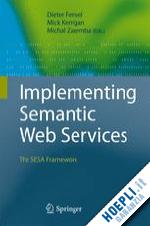
Questo prodotto usufruisce delle SPEDIZIONI GRATIS
selezionando l'opzione Corriere Veloce in fase di ordine.
Pagabile anche con Carta della cultura giovani e del merito, 18App Bonus Cultura e Carta del Docente
Service-oriented computing has become one of the predominant factors in IT research and development efforts over the last few years. In spite of several standardization efforts that advanced from research labs into industrial-strength technologies and tools, there is still much human effort required in the process of finding and executing Web services.
Here, Dieter Fensel and his team lay the foundation for understanding the Semantic Web Services infrastructure, aimed at eliminating human intervention and thus allowing for seamless integration of information systems. They focus on the currently most advanced SWS infrastructure, namely SESA and related work such as the Web Services Execution Environment (WSMX) activities and the Semantic Execution Environment (OASIS SEE TC) standardization effort. Their book is divided into four parts: Part I provides an introduction to the field and its history, covering basic Web technologies and the state of research and standardization in the Semantic Web field. Part II presents the SESA architecture. The authors detail its building blocks and show how they are consolidated into a coherent software architecture that can be used as a blueprint for implementation. Part III gives more insight into middleware services, describing the necessary conceptual functionality that is imposed on the architecture through the basic principles. Each such functionality is realized using a number of so-called middleware services. Finally, Part IV shows how the SESA architecture can be applied to real-world scenarios, and provides an overview of compatible and related systems.
The book targets professionals as well as academic and industrial researchers working on various aspects of semantic integration of distributed information systems. They will learn how to apply the Semantic Web Services infrastructure to automate and semi-automate tasks, by using existing integration technologies. In addition, the book is also suitable for advanced graduate students enrolled in courses covering knowledge management, the Semantic Web, or integration of information systems, as it will educate them about basic technologies for Semantic Web Services and general issues related to integration of information systems.
Dieter Fensel is the Scientific Director of the Digital Enterprise Research Institute (DERI) at the National University of Ireland, Galway since 2003, and the Director of the Digital Enterprise Research Institute (DERI) at the Leopold Franzens University of Innsbruck, Austria, since 2006. His current research interests are around the usage of semantics in 21st century computer science. Dieter published numerous books and papers about ontologies, the Semantic Web, and Semantic Web Services for more than a decade.
Michal Zaremba is a researcher with DERI, working as system architect and developer in Semantic Web service systems and also leading the Semantic Execution Environment cluster. He is a founding member of the WSMO and WSMX working groups and member of the Semantic Web services Interest Group (SWSI) and the Semantic Web services Architecture Committee (SWSA). Michal is a chair of the Semantic Execution Environment (SEE) Technical Committee (TC) and has been an observer to several other TCs, as well as a contributor to the open source implementation of the ebXML registry/repository. His current research interests include Semantic Web Services, eBusiness, Enterprise Application Integration, B2B Integration as well as Business Process Management.
Mick Kerrigan is a PhD researcher in the Digital Enterprise Research Institute (DERI) located in Leopold-Franz University Innsbruck, Austria. Over the last year he has been primarily involved in the WSMX working group focusing on front-end tools for Semantic Web Services. The primary output of his work has been the Web Service Modeling Toolkit, a collection of tools for Semantic Web Services, focusing on tools for creating and managing WSMO descriptions. Mick is also a contributor to and the secretary of the OASIS Semantic Execution Environment technical committee (SEE TC).











Il sito utilizza cookie ed altri strumenti di tracciamento che raccolgono informazioni dal dispositivo dell’utente. Oltre ai cookie tecnici ed analitici aggregati, strettamente necessari per il funzionamento di questo sito web, previo consenso dell’utente possono essere installati cookie di profilazione e marketing e cookie dei social media. Cliccando su “Accetto tutti i cookie” saranno attivate tutte le categorie di cookie. Per accettare solo deterninate categorie di cookie, cliccare invece su “Impostazioni cookie”. Chiudendo il banner o continuando a navigare saranno installati solo cookie tecnici. Per maggiori dettagli, consultare la Cookie Policy.